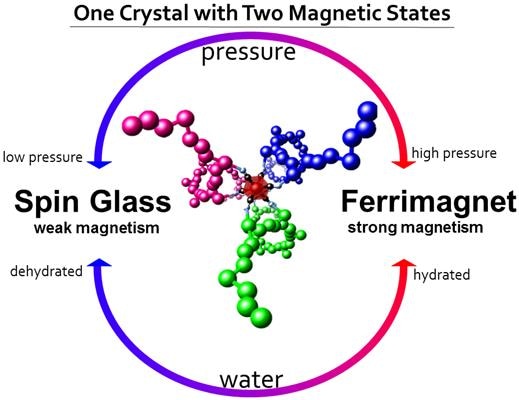Aug 4 2016
Researchers at Hiroshima University, CNRS, and de Strasbourg synthesized crystals with magnetic properties that can change continuously and reversibly, a world first. The study was highlighted as a cover article of the journal “Inorganic Chemistry,” a publication of the American Chemical Society in March 2016.
 A crystal molecule makes a reversible transition between two different magnetic states. The three-strand helix-shaped structure of the crystal has two magnetic states and researchers can cause the crystal to transition between states using humidity and pressure. As a chiral, multi-state magnet, the molecule holds great potential for spintronic devices. (Credit: Li Li, Hiroshima University)
A crystal molecule makes a reversible transition between two different magnetic states. The three-strand helix-shaped structure of the crystal has two magnetic states and researchers can cause the crystal to transition between states using humidity and pressure. As a chiral, multi-state magnet, the molecule holds great potential for spintronic devices. (Credit: Li Li, Hiroshima University)
Recently, the scientific community has had immense interest in new types of magnets with the potential to create the next generation of energy efficient devices through innovations using materials science techniques.
Common magnets, like those holding reminders on home refrigerators or turning car motors, are made of metal and metal oxides. Newer magnets can be made with organic molecules and can have a range of magnetic behaviors because of variations in their molecular structure.
That range of behavior includes the strongly magnetic ferrimagnetic state and the very weakly magnetic spin glass state.
The different seasons in Hiroshima, Japan can affect the humidity inside office and research buildings throughout the year. Crystals prepared in different seasons showed different magnetic properties even though their crystal structures were almost identical.
“To find the source of the different magnetic states, we prepared the crystals under controlled conditions of temperature and humidity,” said Li Li, first author of the research paper and a Ph.D. student in the Department of Chemistry at Hiroshima University.
The crystals synthesized by the research team can exist in either the ferrimagnetic or spin glass state, depending on the conditions of how they are synthesized. This is the first material known to reversibly and continuously transition between magnetic states.
As the crystals absorb water from the air, they undergo subtle structural changes responsible for the continuous transformation between ferrimagnet and spin glass. By applying pressure, the effect can be reversed. This allows fine-tuning of the magnetic states, and explains why the humidity in the research lab can affect the crystals.
Using the research team’s synthesis methods, increasing the pressure on the crystal changes the spin glass state into the ferrimagnet state and drying the crystal changes ferrimagnet into spin glass. Pressure and humidity are like dimmer switches to slide the crystal back and forth between the two states.
Additionally, the crystal is chiral, meaning it can exist in either one orientation or its own mirror image. These mirror image versions of the molecule are not superimposable, like right and left human hands.
Both right-handed and left-handed versions of the crystals can transition between the ferrimagnet and spin glass states. However, there are valuable applications exclusive to chiral molecules due to their unique chemical and optical properties.
“Our laboratory primarily researches chiral magnets, but this is the first time we found one compound with multiple magnetic states,” said Katsuya Inoue, Ph.D., one of the researchers involved and the leader of Hiroshima University’s Center for Chiral Science.
Chiral magnets can be used in spintronics devices, which are the current state-of-the-art data storage technology that use less power, are faster, and can store more information than previous generations of computer hard drives.
“We imagine that a chiral material with two or more magnetic states will provide further technological advantages because of its handedness,” said Inoue.
“This is a brand new breed of molecular material and it requires finesse to synthesize. Our results might not lead directly to immediate practical applications, but advances made in the science of chiral magnets are generating properties not experienced before, opening a bright future of new innovations,” said Inoue.